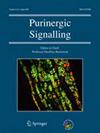骨髓中浆细胞通过 P2X4 受体存活需要由 pannexin-3 介导的 ATP 释放。
IF 2.4
4区 医学
Q2 NEUROSCIENCES
引用次数: 0
摘要
本文章由计算机程序翻译,如有差异,请以英文原文为准。
ATP release mediated by pannexin-3 is required for plasma cell survival via P2X4 receptors in bone marrow.
求助全文
通过发布文献求助,成功后即可免费获取论文全文。
去求助
来源期刊

Purinergic Signalling
医学-神经科学
CiteScore
6.60
自引率
17.10%
发文量
75
审稿时长
6-12 weeks
期刊介绍:
Nucleotides and nucleosides are primitive biological molecules that were utilized early in evolution both as intracellular energy sources and as extracellular signalling molecules. ATP was first identified as a neurotransmitter and later as a co-transmitter with all the established neurotransmitters in both peripheral and central nervous systems. Four subtypes of P1 (adenosine) receptors, 7 subtypes of P2X ion channel receptors and 8 subtypes of P2Y G protein-coupled receptors have currently been identified. Since P2 receptors were first cloned in the early 1990’s, there is clear evidence for the widespread distribution of both P1 and P2 receptor subtypes in neuronal and non-neuronal cells, including glial, immune, bone, muscle, endothelial, epithelial and endocrine cells.
 求助内容:
求助内容: 应助结果提醒方式:
应助结果提醒方式:


